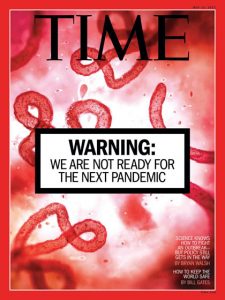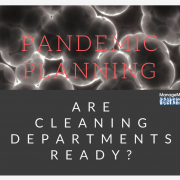Experts Warn That a Global Pandemic is Around the Corner, but are Cleaning Departments Ready?
The cover of this week’s Time Magazine will likely to grab your attention.

In the article, “The World is Not Ready for the Next Pandemic,” journalist Bryan Walsh chronicles the latest pandemic percolating across China—a new strain of the bird flu called H7N9. While it “mostly” affects poultry, the virus has jumped to humans, resulting in pneumonia (88 percent) and the death (41 percent) of its approximately 1,500 victims.
Experts say that the virus can only be transmitted from poultry to humans at this point, but that’s likely to change. The potential for the virus to evolve and become transmittable between humans is so great that the U.S. Centers for Disease Control and Prevention (CDC) ranks H7N9 as the flu strain with the greatest potential to cause a pandemic.
The author notes:
And while a mutant bug that moves from chickens in China to humans in cities around the world may seem like something out of a Hollywood script, the danger the world faces from H7N9–and countless other pathogens with the potential to cause enormous harm–isn’t science fiction. Rather, it’s the highly plausible nightmare scenario that should be keeping the President up at night.
Scary stuff. But it’s even scarier for custodial workers who will be on the front lines of the battle, should the virus evolve. While we can’t know exactly how, when or even if it will spread, there’s a good chance that if it’s not H7N9, another virus will come along that will threaten our health and security.
This isn’t the first time that custodial workers have been challenged with the important job of preventing the spread of infection outside of healthcare facilities. It happened in 2009 with the H1N1 (Swine Flu) outbreak, in 2014 with the Ebola outbreak—it happens each year during cold and flu season.
Because many viruses can live on hard surfaces for several hours, it can spread “like crazy” between unknowing building occupants. That’s why effective cleaning and disinfection is an essential step to keep high-touch fomites, such as door handles and light switches, free of these viruses. That’s why planning to systematically address cleaning operations in an emergency situation like a pandemic is essential.
If you’re even peripherally associated with the cleaning responsibilities in your business, now is the time to start asking questions about how cleaning will be handled during an outbreak or pandemic situation. Is the custodial staff in your facility equipped with the right tools and knowledge to clean during an outbreak situation?
To help custodial teams prepare, we’ve identified the essential components of an effective pandemic preparedness plan. Your pandemic preparedness plan should include:
- A Playbook. Custodial teams must have a clearly defined action plan for how to respond in an emergency situation. This playbook will offer different scenarios and action plans depending on the virus at hand. In addition to instructions, the playbook should also include emergency contact numbers for key individuals in the building, suppliers and staff.
- Ongoing training for custodial workers. Even before an outbreak occurs, cleaning workers need to have a clear understanding of their responsibilities in an emergency situation. Training should include the following:
- A disinfectant overview: The curriculum should include a primer on the specific viruses the disinfectants are designed to kill and the amount of dwell time required for the virus to be effective. You can’t just spray a disinfectant on a surface and immediately wipe it clean—this will make it completely ineffective. Workers need to understand what to use and how to use it.
- Steps for protecting workers: When custodial workers know and understand the risks, they will be more likely to take precautionary measures. This includes donning specific personal protective equipment (PPE) such as masks or gloves.
- Action plans: Custodial personnel should have a clear understanding of their responsibilities during an outbreak situation. Using a systematic approach to cleaning is an essential step in making sure that surfaces are thoroughly cleaned and disinfected.
- Plans for inventory supply shortages. Supply shortages of commonly used items such as PPE, chemicals, tissues and hand sanitizer are likely to occur during an outbreak situation, so make plans for how to address shortages or stockpile items accordingly.
- Signage. Effective handwashing is key to eliminating potential pathogen encounters. Place signage around the building to remind building occupants to regularly wash their hands to reduce the opportunity for the virus to spread. Signage can also be used to remind custodial workers of their responsibilities, or encourage building occupants to assist with cleaning efforts in their personal workspace.
Custodial workers play a key role in protecting the health and safety of building occupants on a daily basis, but even more so in an outbreak situation. Preparing them with the knowledge and tools they need will go a long way in stopping the spread of an infection.

